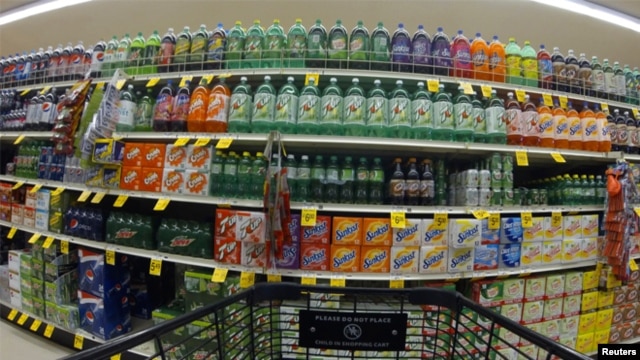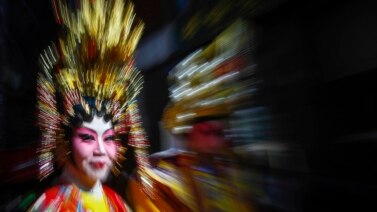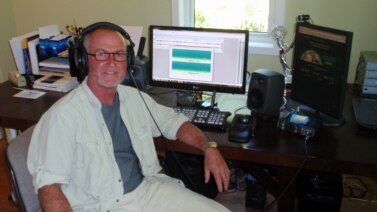
Hello again and welcome to As It Is! I’m Steve Ember in Washington.
Medical experts have long talked about the possible health risks of soft drinks. Now new research suggests that children who drink a lot of soda could become destructive or violent.
“We can’t prove that this is a direct cause and effect relationship. Having said that, there are a lot of ingredients in soda, a lot of ingredients that have not been examined in relation to behavior.”
We will have more on that story later in the program.
But first, there have been many studies done on how color affects emotions. One recent study found that some colors people see late at night could have a harmful effect on their emotions. VOA’s Christopher Cruise has more on the study.
Color of Night Light Could Affect Emotions
Some colors that people see late at night could cause signs of the condition mental health experts call clinical depression. That was the finding of a study that builds on earlier study findings. They showed that individuals who live or work in low levels of light overnight can develop clinical depression.
Doctors use the words clinical depression to describe a severe form of depression. Signs may include loss of interest or pleasure in most activities, low energy levels and thoughts of death or suicide. In the new study, American investigators designed an experiment that exposed hamsters to different colors. The researchers chose hamsters because they are nocturnal, which means they sleep during the day and are active at night.
The animals were separated into four groups. One group of hamsters was kept in the dark during their nighttime period. Another group was placed in front of a blue light. A third group slept in front of a white light, while a fourth was put in front of a red light.
After four weeks, the researchers noted how much sugary water the hamsters drank. They found that the more depressed animals drank the least amount of water.
Randy Nelson heads the Department of Neuroscience at Ohio State University. He says animals that slept in blue and white light appeared to be the most depressed.
“What we saw was these animals didn’t show any sleep disruptions at all but they did have mucked up circadian clock genes and they did show depressive phenotypes whereas if they were in the dim red light, they did not.”
Randy Nelson notes that photosensitive cells in the retina have little to do with eyesight. He says these cells send signals to the area of the brain that controls what has been called the natural sleep-wake cycle. He says there is a lot of blue in white light. This explains why the blue light and white light hamsters appeared to be more depressed than the hamsters seeing red light or darkness.
Mr. Nelson has suggestions for people who work late at night or those who like to stay up late.
“My recommendation is if you are just living a typical, mostly active (life) during the day, mostly inactive at night, you want to limit the exposure to TVs, which are quite bluish in the light they give off, and computer screens and things like that. You can get filtered glasses, you can get filters on your computer screen or your eReaders and that sort of thing to put it more in the reddish light.”
The report on the effects of light on emotions was published in The Journal of Neuroscience.
I’m Christopher Cruise.
Do you have a question or a comment about our show? Or is there something you would like to hear on a future program?
We welcome your suggestions. Send an email to learningenglish@voanews.com. Or you can visit our website at learningenglish.voanews.com, and click on “Contact Us”.
You can also find us on Facebook, YouTube, LinkedIn, iTunes and Twitter at VOA Learning English.
You are listening to As It Is, from VOA Learning English. I’m Steve Ember.
A new study has found evidence of aggressive behavior in children who drink four or more servings of soft drinks every day.
The mothers of 3,000 five-year-olds took part in the study. Researchers asked the women to keep a record of how many servings of soft drinks their children drank over a two-month period. As Bob Doughty reports, the women were also asked to keep records of how the children behaved.
Soda Could Cause Aggressive Behavior in Children
The researchers found that 43 percent of the boys and girls drank at least one daily serving of soda. Four percent of the youngsters had four or more sodas to drink every day.

Shakira Suglia is with Columbia University's Mailman School of Public Health in New York City. She worked on the study with researchers from the University of Vermont and Harvard University School of Public Health. She says they found that children who drank the most soda were more than two times as likely as those who drank no soda to show signs of aggression.
“For the children who consumed four or more soft drinks per day, we see an association between aggressive behaviors, attention problems and withdrawn behaviors.”
The aggressive behaviors included destroying possessions belonging to others, taking part in fights and physically attacking people.
Shakira Suglia says the researchers identified the link after they considered socio-demographic factors like the child’s age and sex. They also considered other possible influences, such as whether the boys and girls were eating sweets or given fruit drinks on a normal day. In addition, the researchers examined parenting styles and other social conditions that might be taking place in the home.
Doctor Suglia says it is not clear why young children who drink a lot of soda have behavior problems.
“We can’t prove that this is a direct cause and effect relationship. Having said that, there are a lot of ingredients in soda, a lot of ingredients that have not been examined in relation to behavior.”
A substance often found in soft drinks is caffeine, which helps to make people feel energized. Doctor Suglia suggests that caffeine could be causing the five year olds to be more aggressive.
The research is part of a larger study called the Fragile Families and Child Wellbeing Study. It follows 5,000 poor mothers and their children in 20 American cities.
Earlier studies of young adults have found the highest sugar levels in those who carry weapons and show signs of negative social behavior.
I’m Bob Doughty.
And that’s our program for today. For more stories like these, visit our website -- learningenglish.voanews.com. While you are there, click on “Contact Us” and let us know what you would like to hear about on future programs.
Christopher Cruise returns tomorrow with another As It Is. I’m Steve Ember. Thanks for joining us.





